The Relationship Between Childhood Trauma and Anxiety in Adolescents
VerifiedAdded on 2022/08/09
|5
|1083
|24
Discussion Board Post
AI Summary
This discussion post explores the relationship between childhood trauma and the development of anxiety disorders in adolescents. The assignment begins by defining anxiety and its prevalence in children, highlighting the impact of childhood trauma, hereditary factors, and environmental influences. It focuses on the research question: Does childhood trauma lead to anxiety in adolescents? The post also presents a hypothesis, including both an alternative and null hypothesis, outlining how traumatic experiences may contribute to anxiety disorders. The post references several studies that support the association between childhood trauma and anxiety. The discussion also touches on the impact of anxiety on adolescents' quality of life, including social withdrawal, academic difficulties, and the increased risk of substance abuse and physical comorbidities. The post emphasizes the need for trauma prevention to reduce the incidence of psychiatric disorders.
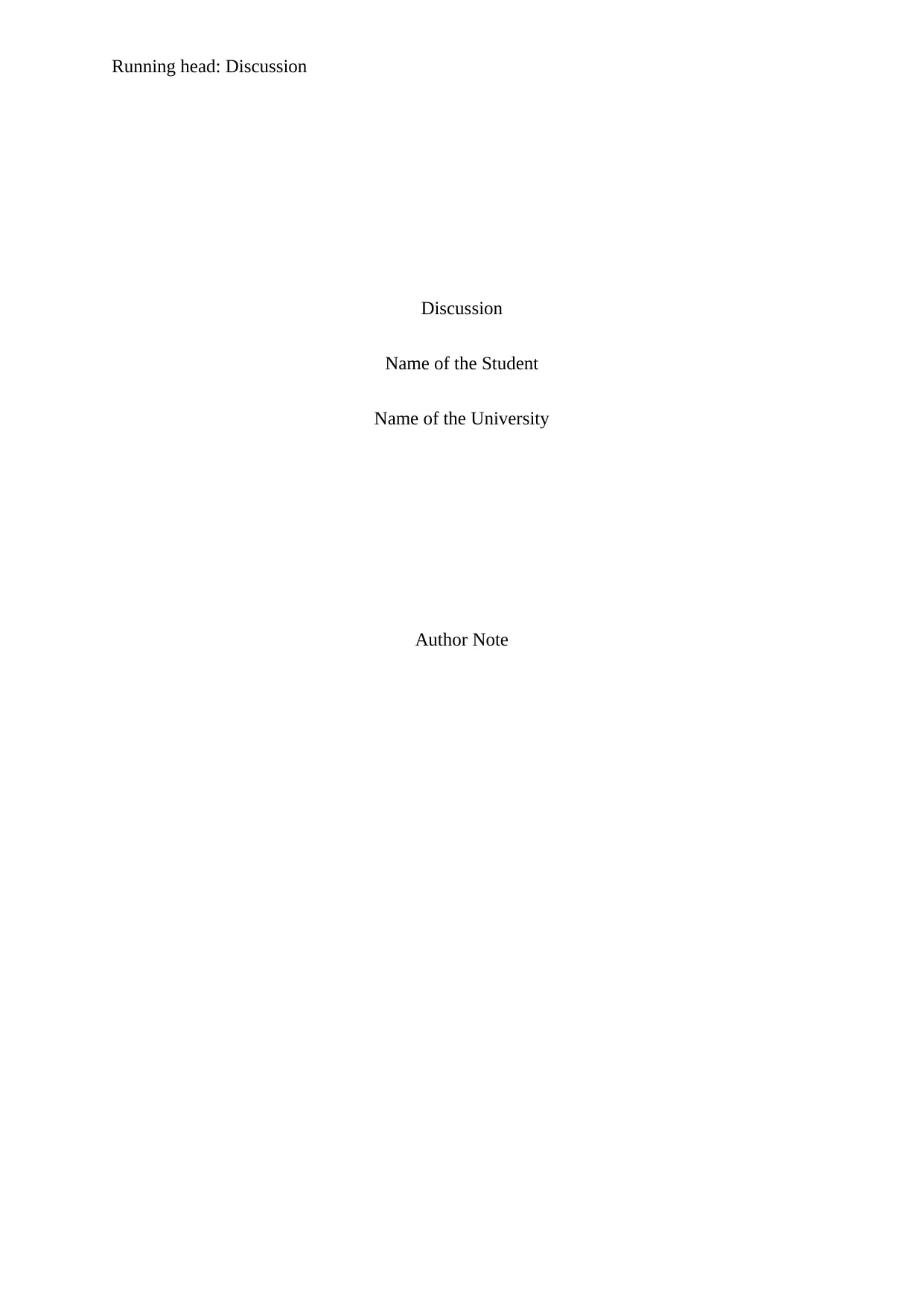
Running head: Discussion
Discussion
Name of the Student
Name of the University
Author Note
Discussion
Name of the Student
Name of the University
Author Note
Paraphrase This Document
Need a fresh take? Get an instant paraphrase of this document with our AI Paraphraser
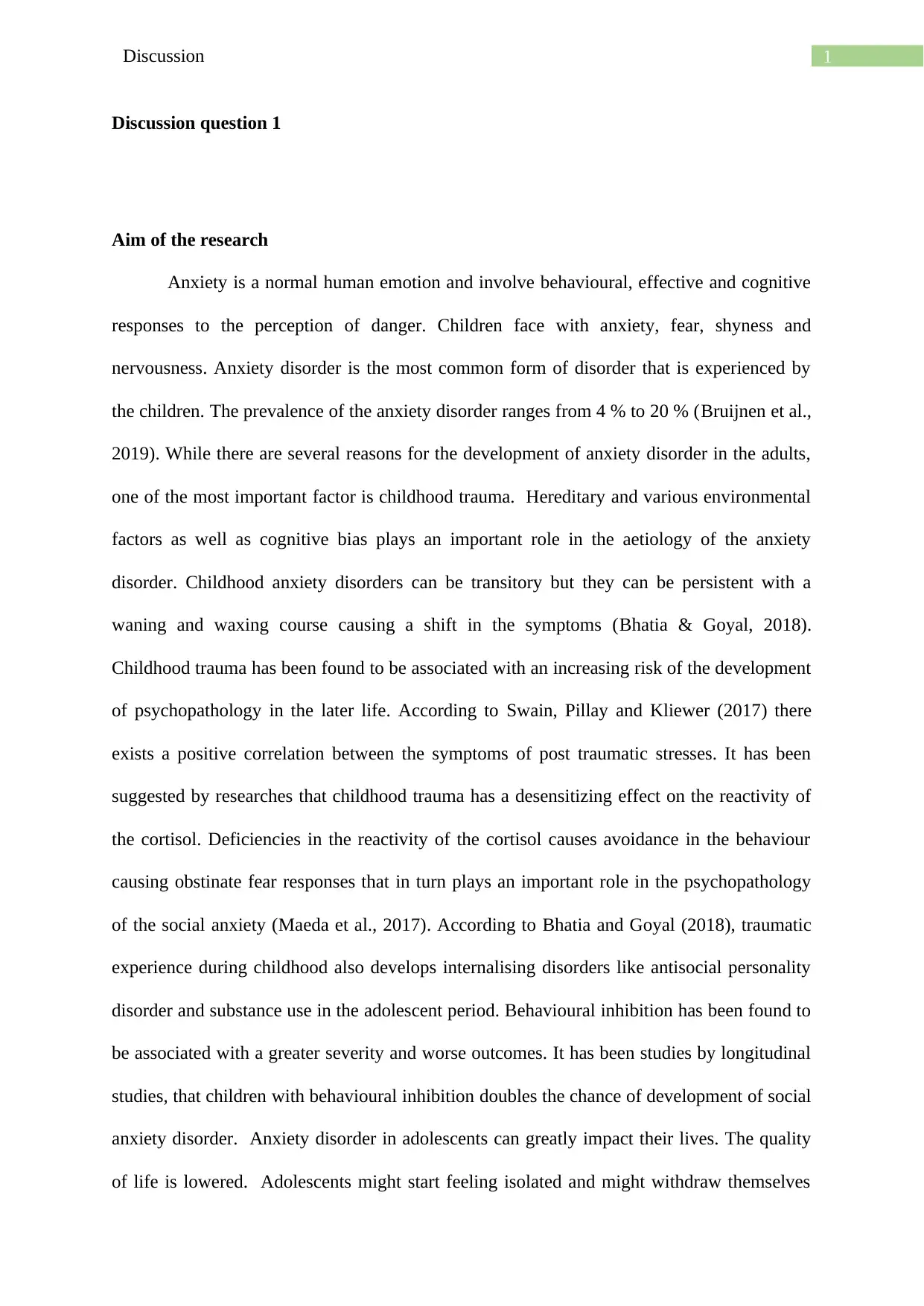
1Discussion
Discussion question 1
Aim of the research
Anxiety is a normal human emotion and involve behavioural, effective and cognitive
responses to the perception of danger. Children face with anxiety, fear, shyness and
nervousness. Anxiety disorder is the most common form of disorder that is experienced by
the children. The prevalence of the anxiety disorder ranges from 4 % to 20 % (Bruijnen et al.,
2019). While there are several reasons for the development of anxiety disorder in the adults,
one of the most important factor is childhood trauma. Hereditary and various environmental
factors as well as cognitive bias plays an important role in the aetiology of the anxiety
disorder. Childhood anxiety disorders can be transitory but they can be persistent with a
waning and waxing course causing a shift in the symptoms (Bhatia & Goyal, 2018).
Childhood trauma has been found to be associated with an increasing risk of the development
of psychopathology in the later life. According to Swain, Pillay and Kliewer (2017) there
exists a positive correlation between the symptoms of post traumatic stresses. It has been
suggested by researches that childhood trauma has a desensitizing effect on the reactivity of
the cortisol. Deficiencies in the reactivity of the cortisol causes avoidance in the behaviour
causing obstinate fear responses that in turn plays an important role in the psychopathology
of the social anxiety (Maeda et al., 2017). According to Bhatia and Goyal (2018), traumatic
experience during childhood also develops internalising disorders like antisocial personality
disorder and substance use in the adolescent period. Behavioural inhibition has been found to
be associated with a greater severity and worse outcomes. It has been studies by longitudinal
studies, that children with behavioural inhibition doubles the chance of development of social
anxiety disorder. Anxiety disorder in adolescents can greatly impact their lives. The quality
of life is lowered. Adolescents might start feeling isolated and might withdraw themselves
Discussion question 1
Aim of the research
Anxiety is a normal human emotion and involve behavioural, effective and cognitive
responses to the perception of danger. Children face with anxiety, fear, shyness and
nervousness. Anxiety disorder is the most common form of disorder that is experienced by
the children. The prevalence of the anxiety disorder ranges from 4 % to 20 % (Bruijnen et al.,
2019). While there are several reasons for the development of anxiety disorder in the adults,
one of the most important factor is childhood trauma. Hereditary and various environmental
factors as well as cognitive bias plays an important role in the aetiology of the anxiety
disorder. Childhood anxiety disorders can be transitory but they can be persistent with a
waning and waxing course causing a shift in the symptoms (Bhatia & Goyal, 2018).
Childhood trauma has been found to be associated with an increasing risk of the development
of psychopathology in the later life. According to Swain, Pillay and Kliewer (2017) there
exists a positive correlation between the symptoms of post traumatic stresses. It has been
suggested by researches that childhood trauma has a desensitizing effect on the reactivity of
the cortisol. Deficiencies in the reactivity of the cortisol causes avoidance in the behaviour
causing obstinate fear responses that in turn plays an important role in the psychopathology
of the social anxiety (Maeda et al., 2017). According to Bhatia and Goyal (2018), traumatic
experience during childhood also develops internalising disorders like antisocial personality
disorder and substance use in the adolescent period. Behavioural inhibition has been found to
be associated with a greater severity and worse outcomes. It has been studies by longitudinal
studies, that children with behavioural inhibition doubles the chance of development of social
anxiety disorder. Anxiety disorder in adolescents can greatly impact their lives. The quality
of life is lowered. Adolescents might start feeling isolated and might withdraw themselves
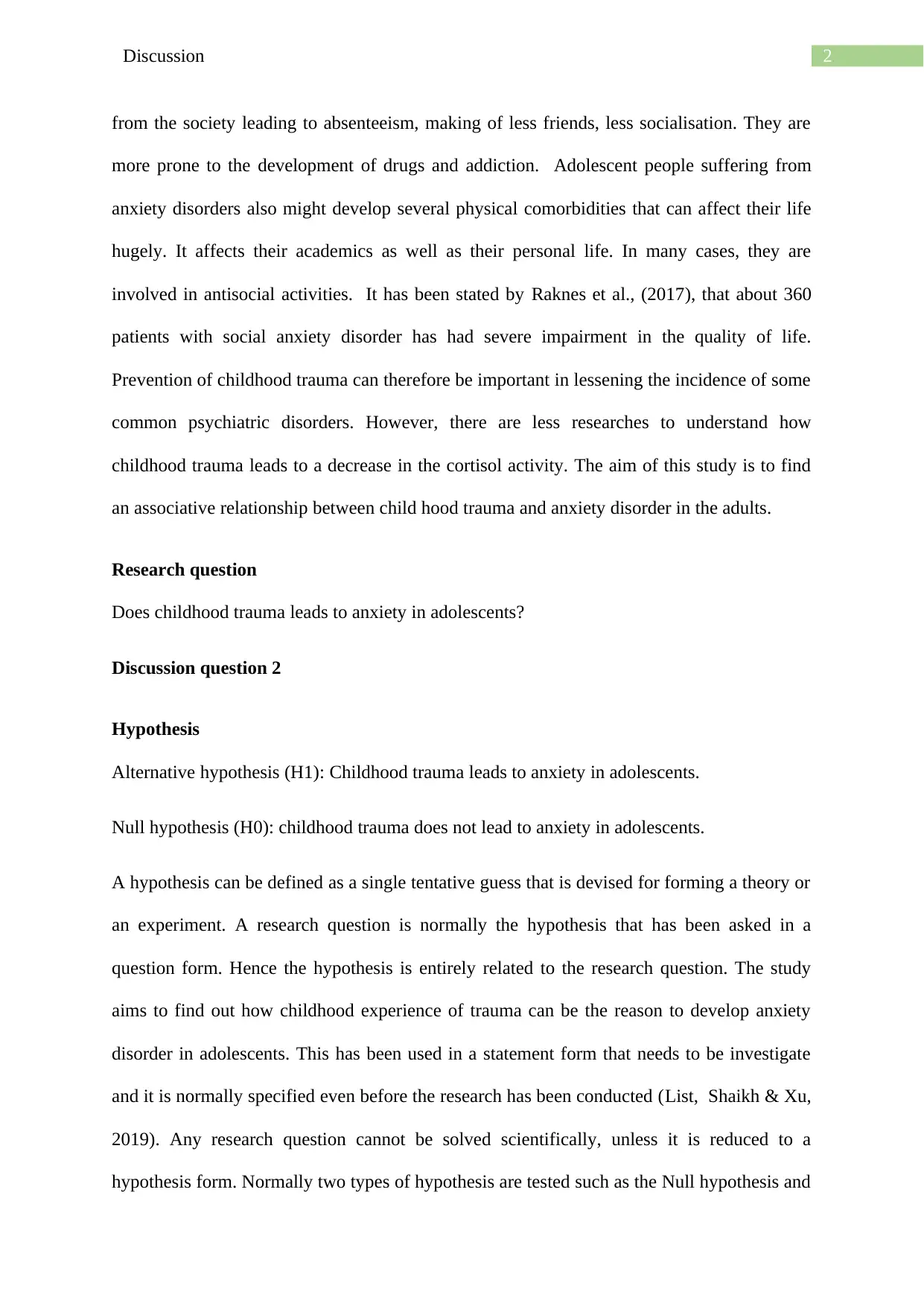
2Discussion
from the society leading to absenteeism, making of less friends, less socialisation. They are
more prone to the development of drugs and addiction. Adolescent people suffering from
anxiety disorders also might develop several physical comorbidities that can affect their life
hugely. It affects their academics as well as their personal life. In many cases, they are
involved in antisocial activities. It has been stated by Raknes et al., (2017), that about 360
patients with social anxiety disorder has had severe impairment in the quality of life.
Prevention of childhood trauma can therefore be important in lessening the incidence of some
common psychiatric disorders. However, there are less researches to understand how
childhood trauma leads to a decrease in the cortisol activity. The aim of this study is to find
an associative relationship between child hood trauma and anxiety disorder in the adults.
Research question
Does childhood trauma leads to anxiety in adolescents?
Discussion question 2
Hypothesis
Alternative hypothesis (H1): Childhood trauma leads to anxiety in adolescents.
Null hypothesis (H0): childhood trauma does not lead to anxiety in adolescents.
A hypothesis can be defined as a single tentative guess that is devised for forming a theory or
an experiment. A research question is normally the hypothesis that has been asked in a
question form. Hence the hypothesis is entirely related to the research question. The study
aims to find out how childhood experience of trauma can be the reason to develop anxiety
disorder in adolescents. This has been used in a statement form that needs to be investigate
and it is normally specified even before the research has been conducted (List, Shaikh & Xu,
2019). Any research question cannot be solved scientifically, unless it is reduced to a
hypothesis form. Normally two types of hypothesis are tested such as the Null hypothesis and
from the society leading to absenteeism, making of less friends, less socialisation. They are
more prone to the development of drugs and addiction. Adolescent people suffering from
anxiety disorders also might develop several physical comorbidities that can affect their life
hugely. It affects their academics as well as their personal life. In many cases, they are
involved in antisocial activities. It has been stated by Raknes et al., (2017), that about 360
patients with social anxiety disorder has had severe impairment in the quality of life.
Prevention of childhood trauma can therefore be important in lessening the incidence of some
common psychiatric disorders. However, there are less researches to understand how
childhood trauma leads to a decrease in the cortisol activity. The aim of this study is to find
an associative relationship between child hood trauma and anxiety disorder in the adults.
Research question
Does childhood trauma leads to anxiety in adolescents?
Discussion question 2
Hypothesis
Alternative hypothesis (H1): Childhood trauma leads to anxiety in adolescents.
Null hypothesis (H0): childhood trauma does not lead to anxiety in adolescents.
A hypothesis can be defined as a single tentative guess that is devised for forming a theory or
an experiment. A research question is normally the hypothesis that has been asked in a
question form. Hence the hypothesis is entirely related to the research question. The study
aims to find out how childhood experience of trauma can be the reason to develop anxiety
disorder in adolescents. This has been used in a statement form that needs to be investigate
and it is normally specified even before the research has been conducted (List, Shaikh & Xu,
2019). Any research question cannot be solved scientifically, unless it is reduced to a
hypothesis form. Normally two types of hypothesis are tested such as the Null hypothesis and
⊘ This is a preview!⊘
Do you want full access?
Subscribe today to unlock all pages.

Trusted by 1+ million students worldwide
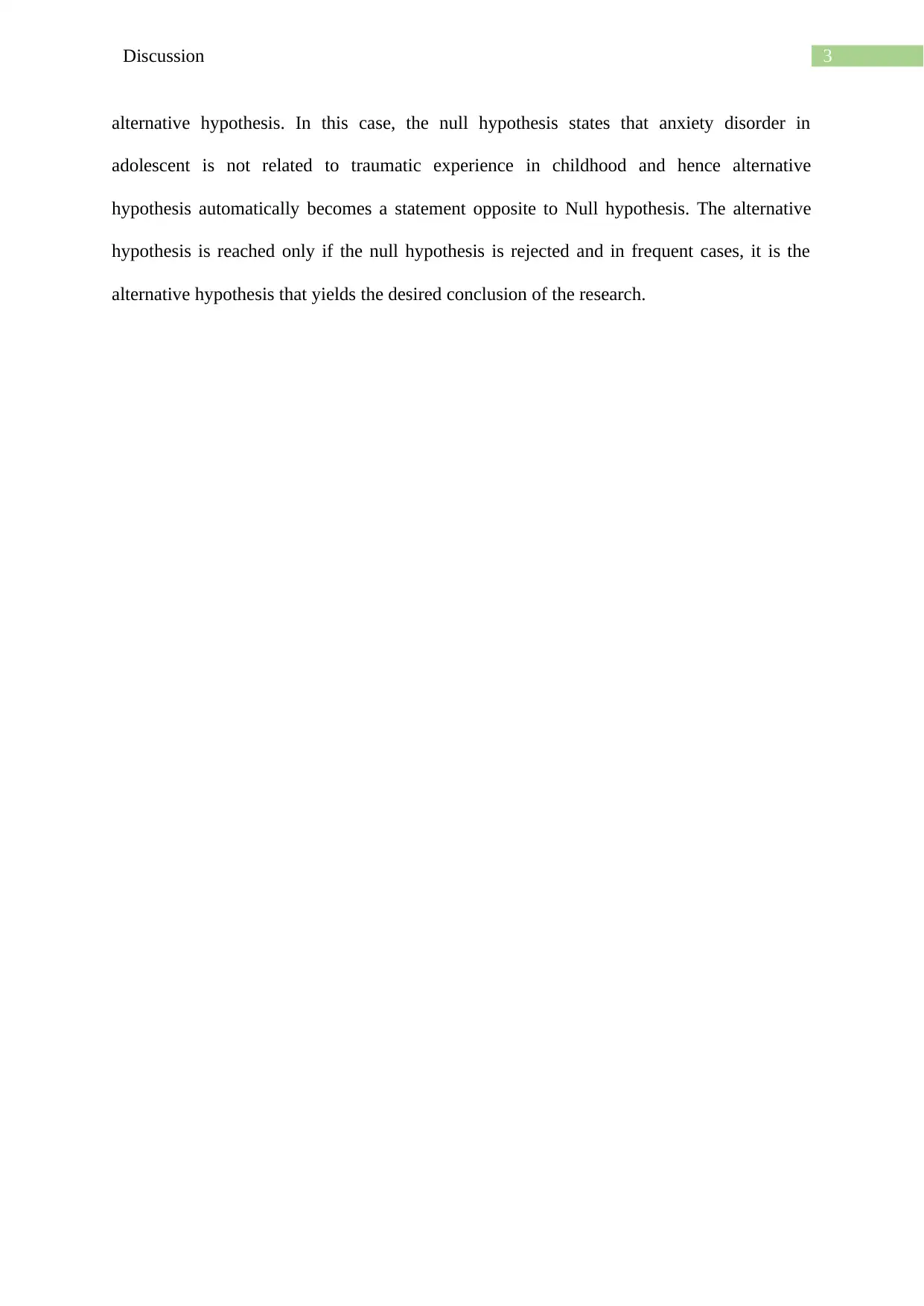
3Discussion
alternative hypothesis. In this case, the null hypothesis states that anxiety disorder in
adolescent is not related to traumatic experience in childhood and hence alternative
hypothesis automatically becomes a statement opposite to Null hypothesis. The alternative
hypothesis is reached only if the null hypothesis is rejected and in frequent cases, it is the
alternative hypothesis that yields the desired conclusion of the research.
alternative hypothesis. In this case, the null hypothesis states that anxiety disorder in
adolescent is not related to traumatic experience in childhood and hence alternative
hypothesis automatically becomes a statement opposite to Null hypothesis. The alternative
hypothesis is reached only if the null hypothesis is rejected and in frequent cases, it is the
alternative hypothesis that yields the desired conclusion of the research.
Paraphrase This Document
Need a fresh take? Get an instant paraphrase of this document with our AI Paraphraser
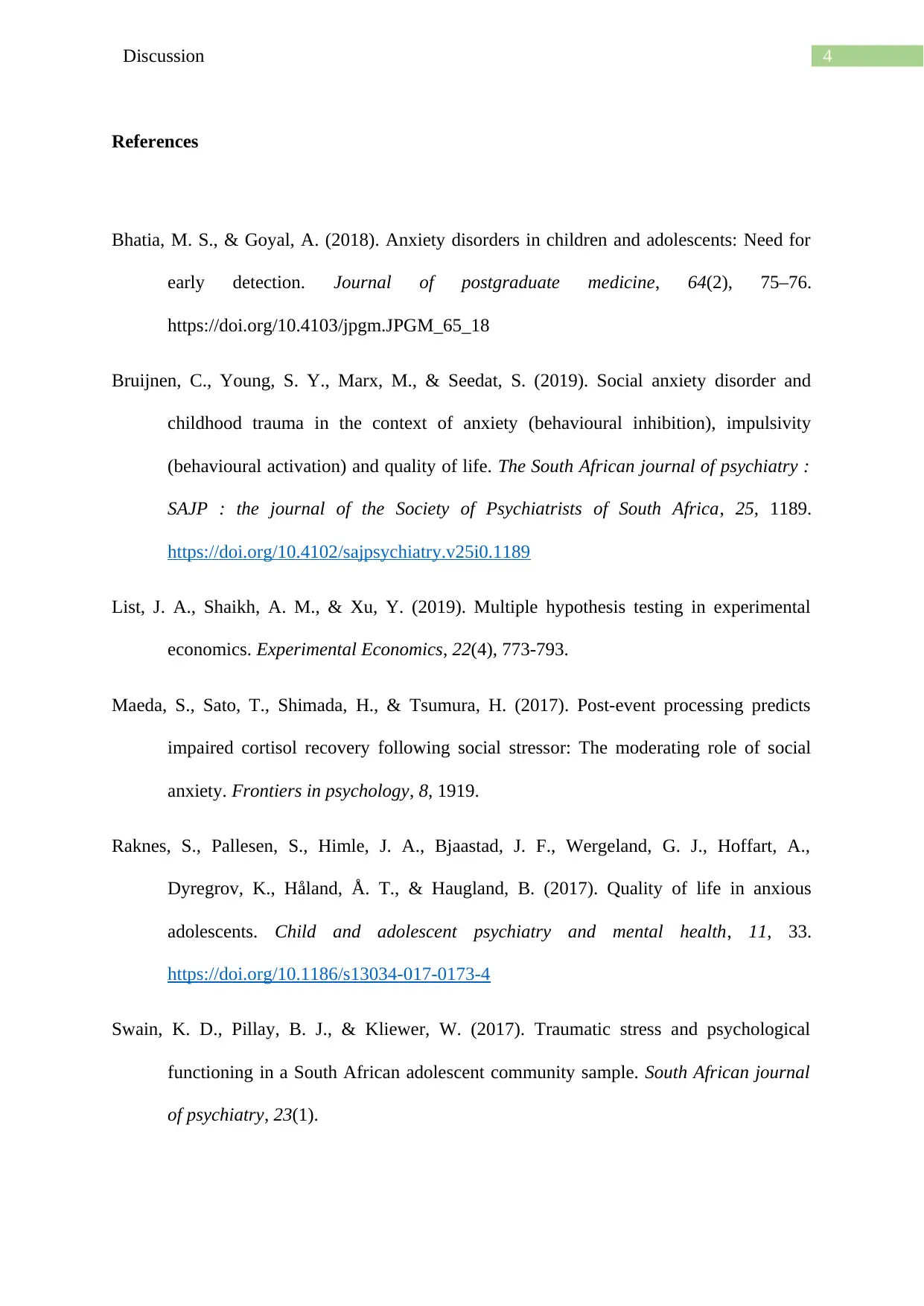
4Discussion
References
Bhatia, M. S., & Goyal, A. (2018). Anxiety disorders in children and adolescents: Need for
early detection. Journal of postgraduate medicine, 64(2), 75–76.
https://doi.org/10.4103/jpgm.JPGM_65_18
Bruijnen, C., Young, S. Y., Marx, M., & Seedat, S. (2019). Social anxiety disorder and
childhood trauma in the context of anxiety (behavioural inhibition), impulsivity
(behavioural activation) and quality of life. The South African journal of psychiatry :
SAJP : the journal of the Society of Psychiatrists of South Africa, 25, 1189.
https://doi.org/10.4102/sajpsychiatry.v25i0.1189
List, J. A., Shaikh, A. M., & Xu, Y. (2019). Multiple hypothesis testing in experimental
economics. Experimental Economics, 22(4), 773-793.
Maeda, S., Sato, T., Shimada, H., & Tsumura, H. (2017). Post-event processing predicts
impaired cortisol recovery following social stressor: The moderating role of social
anxiety. Frontiers in psychology, 8, 1919.
Raknes, S., Pallesen, S., Himle, J. A., Bjaastad, J. F., Wergeland, G. J., Hoffart, A.,
Dyregrov, K., Håland, Å. T., & Haugland, B. (2017). Quality of life in anxious
adolescents. Child and adolescent psychiatry and mental health, 11, 33.
https://doi.org/10.1186/s13034-017-0173-4
Swain, K. D., Pillay, B. J., & Kliewer, W. (2017). Traumatic stress and psychological
functioning in a South African adolescent community sample. South African journal
of psychiatry, 23(1).
References
Bhatia, M. S., & Goyal, A. (2018). Anxiety disorders in children and adolescents: Need for
early detection. Journal of postgraduate medicine, 64(2), 75–76.
https://doi.org/10.4103/jpgm.JPGM_65_18
Bruijnen, C., Young, S. Y., Marx, M., & Seedat, S. (2019). Social anxiety disorder and
childhood trauma in the context of anxiety (behavioural inhibition), impulsivity
(behavioural activation) and quality of life. The South African journal of psychiatry :
SAJP : the journal of the Society of Psychiatrists of South Africa, 25, 1189.
https://doi.org/10.4102/sajpsychiatry.v25i0.1189
List, J. A., Shaikh, A. M., & Xu, Y. (2019). Multiple hypothesis testing in experimental
economics. Experimental Economics, 22(4), 773-793.
Maeda, S., Sato, T., Shimada, H., & Tsumura, H. (2017). Post-event processing predicts
impaired cortisol recovery following social stressor: The moderating role of social
anxiety. Frontiers in psychology, 8, 1919.
Raknes, S., Pallesen, S., Himle, J. A., Bjaastad, J. F., Wergeland, G. J., Hoffart, A.,
Dyregrov, K., Håland, Å. T., & Haugland, B. (2017). Quality of life in anxious
adolescents. Child and adolescent psychiatry and mental health, 11, 33.
https://doi.org/10.1186/s13034-017-0173-4
Swain, K. D., Pillay, B. J., & Kliewer, W. (2017). Traumatic stress and psychological
functioning in a South African adolescent community sample. South African journal
of psychiatry, 23(1).
1 out of 5
Related Documents
Your All-in-One AI-Powered Toolkit for Academic Success.
+13062052269
info@desklib.com
Available 24*7 on WhatsApp / Email
![[object Object]](/_next/static/media/star-bottom.7253800d.svg)
Unlock your academic potential
Copyright © 2020–2025 A2Z Services. All Rights Reserved. Developed and managed by ZUCOL.




